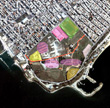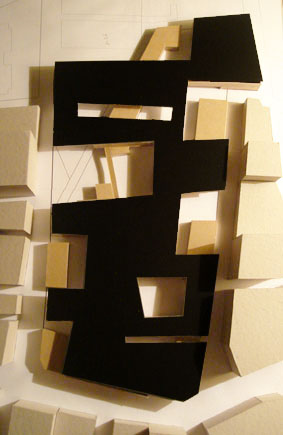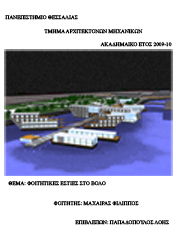The intervention is located inside the Krafsidon river in Volos and aims to create a fragile situation between the urban scale uses of land situated along the river bed.
Almost water is a parametrical system that changes in order to accommodate different functions. Water because the aquatic element is approached both according to its form and its flow pattern. Almost because an attempt is made to create an in-between situation that is constantly evolving, following with some divergence the presence and the absence of water and also because it suggests a sequence of uses by removing the strict boundaries, a sequence from the useless to the useful, one open transition from situation to situation. The constantly changing presence of water and its key position – as an in-between dead space – has lead to the quest for a less “confined” situation.
Finding the sense of time, both because of the evolution of the program as well as because of the unstable presence of the water, has lead to the need to design a system that could evolve either by obeying a rule or by ignoring it. Elasticity in both form and use interpretation is wanted. Looking for fluidity through form, entered discontinuity and the alternation between thickness and scarceness.
Supervisor: Gavrilou Evelyn
Reference Number: 311


Nell progetto per la scuola che abbaimo disegnato,il quale si trova nella citta di Volos,orientato alla Grecia centrale,la sovrapposizione spaziale e visiva delle funzioni e la sinergia dell loro utilizzo costituiscono la logica operative fondamentale che caratterizza l’edificio.Tra l’altro,abbiamo anche insistito sulle dualita concettuali che definiscono l’appezzamento di terreno nel perimetro dell area.Le dualita che abbiamo usato nel proprio vocabolario espressivo sono:cemento armato e verde,pieno e vuoto,freddo e caldo,spirituale e fisico.E proprio questa opposizione di line di forza determina il risultato finale:un volume unico,enigmatico e compatto,che unisce la scuola al complesso,con intricate relazioni spaziali in contrasto con il vasto paesaggio pianeggiante(il fiume Krausidonas,il monte di Pelio),al centro dell’ area dove emerge la figura dell’edificio-una zona commune-,un insieme contraddittirio della forma delle scuole dove non c’e un fronte e un retro,e che e totalmente privo di gerarchie o di autorita.Fino a che punto abbia trasceso le preoccupazioni stilistiche e le classificazioni linguistiche nell’ era delle nuove culture emergenti e un interrogative da capire e da analizzare attentamente dopo questa prima presentazione critica.
Supervisors: Triantafillidis Giorgos, Tsangrassoulis Aris
Reference Number: 260


Initially, the historical direction of development of the city of Thessaloniki is remarked, as a pattern of transporting and commercial crossing through land and sea (through terrestrial and marine paths). Morphological transformations of urban map are indicated during several historical periods in relationship with political, social and financial dominant conditions.
The reforms (Tanzimat) that took place in the 19th century, the consequences by fires in 1890 and 1917, the causes from lack of generalized practice of Hébrard’s drawings and the new reality of the refugees’ arrival from 1922 to 1928, are underlined. The reasons and the consequences of the overall urban design abandonment are revealed, as a result among others the tragic shortage of places of social infrastructure and parks.
Specifically, some general and specific intentions of the 1985 regulatory plan in each of his sectors and its choices are mentioned. The references to military camps of Thessaloniki urban area that are the only available free unbuilt spaces inside the urban plan, and their role are examined.
Military camps inside Thessaloniki urban area (15), their characteristics, their spatial size and the general urban plan dimensions are counted. The legislative frame of military camps’ removal, the problems that the latter creates, the attempts for their obtuseness through a system of exchange are into research.
Military camps’ role and practice of institutions of self government and other institutions for their accession are into complete examination, pointing series of several differential aims. The necessity to change choices is required; concerning land use, that has been provided for military camp places, because of conditional modifications and mostly, because of the fact that city needs places of social infrastructure, free unbuilt spaces and parks.
After approaching a general consideration into the issue “urban parks” (urban green) relatively to: firstly, everyday living conditions in Thessaloniki, secondly, emissions in the atmosphere, thirdly, what does cause them, and finally, several methods for their elimination, a joint planning framework for military camps is organized.
The generalized plan is based on standards of green development, ecology and sustainability. Viability of Thessaloniki urban area overall represents its purpose.
It is recommended the characterization of military camps of Thessaloniki urban area, that are not built, into urban green areas or parks, keeping only the remarkable buildings that could accommodate/host social activities.
Especially as far as the military camps are concerned:
Northwest are Ziaka (municipality of Menemeni), Papakyriazi (municipality of Evosmos), Alexander the Great (municipality of Ambelokipoi), Pavlos Melas (municipality of Stavroypoli) and Karatassoy (municipality of Polixni). It is recommended to become an arch of free unbuilt places, through urban and circulatory interventions.
In the center are Kapetan Kotta (former 424 military Hospital) and Field of Mars, (municipality of Thessaloniki), that are suggested to be transformed into a Metropolitan Park and incorporated inside the Cultural Metropolitan Center.
Southeast are Farmaki (municipality of Thessaloniki) and Kodra, Dalipi , (municipality of Kalamaria), as autonomous cores.
From general to specific and from Thessaloniki urban area with its military camps to Kalamaria area with Kodra camp.
Apart from the initial settlement of refugees inside Kodra and after the creation of Kalamaria are, the ownership status of a camp is quite interesting.
Approaching the general urban plan of 1987 and 1999 for Kalamaria area, the cancellation of the latter by the Greek Council of State, and mostly the cancellation reasons, that protect the use “green area” from accompanying activities, such as sports and culture, that cancel the primal use, are into research.
Repeated street plans of Kodra area, regulations from the Ministry of Culture and their relation with today (Cultural Capital, Olympic Games) are recorded.
The architectural Competition of 1994 is introduced from the announcement to the rewards and design studies, giving also some important reasons that canceled its realization. Furthermore, the relative views from the Municipality of Kalamaria are marked too.
Based on a joint planning framework and intervention for the military camps of Thessaloniki urban area, a specific planning framework and intervention for Kodra camp is created, which concerns institutional and methodological options for regulations at the site.
The design proposal is organized after a list of preserved buildings and some chosen for preservation and also subsequent rates calculations for operations and building holding, so as that they would be less than current.
The proposal concerns the values of urban design and is placed between the joint planning framework and intervention for the military camps from Thessaloniki urban area, and the specific planning framework and intervention for Kodra camp, with the aim of sustainable development
Moreover, fundamental principle of the proposal comprises a green park creation, as lung life, with paths-routes for walking, relaxation and pleasure, an artistic and cultural place with environmental sensitivity.
Basic purpose is that Kodra camp remains without buildings, accessible and indivisible. Therefore, it is recommended to maximize its planting surface, away from reconstruction views. In addition, the preserved buildings, that have historical and architectural value, have to become productive, as modern history monuments of the city and the site.
Every spatial formation comes to light from detailed research and exhausting study of current situation, existing green area, mapping, lining, river trace and archeological site. After many different diagrammatic experimental efforts, little by little, piece by piece, the proposal becomes final, deciding on new paths-routes, squares, plateaus, pond (lake), enforcing flora zones, defining again the relationship between man and nature, man and green-water element.
It is decided to organize separable green zones. The transitional zone joins – limits – separates the park from streets, with copse, small wood (forest). The centre of the park that constitutes the base of the green area lung and also has scattered service installations, is modified with low flora (bushes and flowers).
It is about areas of low vegetation into linear orders, copses, river and pond with aquatic plants, open places – squares with stands and pavilions with kiosks, living rooms for stop, relaxation, rest, games, cultural activities. The archeological site is reclaimed and accessible.
The entrance receptions of the park are organized and the areas of culture and relaxation are scattered little by little inside. The different green zones are traced with pedestrian zones and bicycle paths created with natural materials. Vehicles for maintenance and emergency can use these routes. All the other vehicles are rejected completely from the interior of the park.
Apart from the conventional project drawings and the diagrams, there has been experimentation with a variety of alternative ways of expression, based on values of handmade, craft, patchwork, fabric, collage, layers, part object and fragment.
To conclude, Kodra camp has been formed as green area with the character of an urban relaxation park, enriched with plenty of light activities, which will not harm the environment. Ultimately, a metropolitan urban park turns up, a free space flexible to use and friendly to citizens.
Supervisors: Tzirtzilakis Yorgos, Tarani Paraskeui
Reference Number: 282


The present diplomatic project deals with the planning of a school group in Volos, specifically in a region of unmixed residence that constitutes an extension of the city centre. The site has an area of 19.428 sqm. and it hosts today the ‘PanCypriot School’ that was built in 1956, as well as a kindergarten in the south area. However the site was considered naked and available, while its segregation in departments and the bulky architecture of the existing building did not keep pace with the objectives of the proposal. Our initial aim was, therefore, the confrontation of the whole site and the creation of a group of buildings that will utilize the area and the boundaries of the site as much as possible and will function as an organism. Our second objective was the creation of a school that would be addressed to the whole community (Community school), thanks to the existence of a library, theatre, swimming pool, PC centre. For this reasons the solution of a school-village (campus) was selected, that constitutes a micrograph of the city and is developed on the site based on the mapping of the surrounding urban landscape. The buildings that constitute this micropolis, are unified thanks to a uniform canopy that constitutes substantially repetition of the ground at +9.50 meters (multiple levels). Moreover, the segregation of clear school functions (rooms for teaching) from those that would be addressed to all members of community was desirable. Thus the communal functions were placed on the ground level buildings and clear school ones on the first floor. The segregation is obvious thanks to two different vocabularies that dictate the organization, the one of the ground’s (that is organized perimetrically of the site following a development of the limits) and from the other the first floor level (that is developed on a conceivable sub system of streets that resulted from lining out the road network perimetrically). The differentiation of the two levels is also highlighted with the use of different materials (fair-faced concrete for the ground floor buildings, steel for the first floor level ones), in order, finally, two much similar, as much as different systems to be created (ground - ground floor, canopy – first floor), that meet, without however being attached.
Supervisors: Kotionis Zissis, Paniyiris Costis
Reference Number: 266


The diploma project is dealing with an area which is surrounded by two main streets of Thessaloniki, named Kassandrou str and Olympiados str that form an arc. While moving from the city center to the upper city and vice versa, this area comprises a boundary. Main goal of this diploma project is to redefine the site, by proposing different methods of urban design strategies that will result to the improvement of public spaces. Another goal, of the same importance, is to redesign the site in such a way that it will no longer behave as a boundary between the Upper City of Thessaloniki (ANO POLI) and the commercial city center.
A network of pedestrian zones is constructed in order to ensure a smooth flow of movements on ground level. This network is a link among historical landmarks of the area, hub points and main movement axes of the city. Uses of land that are scattered in the research area are reorganized and redistributed. Single unit dwelling is amplified, transformed, under the form of internal zones, and placed on higher levels of apartment buildings. This transformation carries characteristics of the ground level to these higher placed internal zones.
Supervisors: Vyzoviti Sophia, Thermos Kimon
Reference Number: 267


The diplomatic work has as subject the creation of student homes in Volos. The purpose of the operation of the outbreaks is to provide facilities and better living conditions for students during their studies. This strengthens the position of young people from weaker sections, because they not only provided meals and accommodation in hostels, but a part of sports, recreational and spiritual activities.
The contribution of institution of student hearths in the facilitation of students that emanates from unfavourable layers is important and it guarantees the equal confrontation toward the course of young persons to acquisition of identity. Despite this, the way they have legislated and operate this institution through the provision of housing for people coming from certain economic strata leads unintentionally while certainly not marginalized student halls and their tenants. The student home owes and it should it represents a idealistic micrograph of society in which are achieved free trading of opinions and ideas, collective and social conscience, intellectual and bodily vigilance, where the social and economic origin of each one will not constitute parameter. To accomplish this required a diversity of people that can be done by staying in student halls of buildings to those who want no matter the economic situation, coupled with the design and construction of student halls to promote sociability. This would necessitate the construction of a large number of student halls, which is impossible under the budget managed by E.I.N.
The implementation of a scenario such as the establishment of a non-profit organization within the university would undertake the construction and the financial management of student halls collecting money from renting rooms to students without financial difficulty and to provide free housing and meals to economically disadvantage would a balance of population identity of the occupants. The financial amount that would arise from the rental could be used in the maintenance of buildings and to finance new ones.
Supervisor: Papadopoulos Lois
Reference Number: 278


The subject of this dissertation, is to create student accommodations and workshops for the University of Thessaly in the area of the ex A.T.A.C. (Anonymous Alcohol Company of Thessaly) in the district of Saint Anargyron of Volos. The area of study is concentrated on a flat plot of 33.000 square meters at the Kolokotroni street, Papadiamantopoulou street., Oikonomou street and Athonos Trigoni street and is one of the few large scale plots left in the over constructed and fragmented urban landscape.
The building being an old industrial, is a living cultural monument that needs to be protected and well kept, in order to accommodate new uses and functional areas, but always with respect to their identity.
For all the above reasons, our intervention is to reuse the former industrial building, from being a source of pollution to an area of great architectural interest. Workshops for the University of Thessaly are placed at the existing buildings and student accommodations are constructed. Providing uses the city lacks, the building and the area can achieve a more active part in contemporary rhythms and also to restore the essence of the landmark.
Supervisors: Gavrilou Evelyn, Tsangrassoulis Aris, Philippitzis Dimitris
Reference Number: 283


The meaning of City Hall in the digital epoch. Its role. Public building, except of its social destination, is sorted out as a landmark in the city and operates inevitably as an architectural ideal model with important educational meaning ρόλο. City cannot exist without public buildings, and public buildings cannot exist without the city.
But, is the public building simply a receiver of actions and facts or maybe the same building as space entity feeds new activities, new happenings? The relation between building and city is one-to-one, dynamic and unpredictable.
In this architectural proposal I attempt to make this relation beneficial through the functional diosmosis. In a low standard of living area as West Thessaloniki is, City Hall is accepted an emblematic or better a dynamic character, as the dynamicism of society which wishes to change the environment where live in.
That’s my intention, a building – social condenser, with multiple uses, multifunctional and open to society as an organism which is changing, is reinterpreted on and on cause of the activities and facts they are performing in.
Supervisor: Stylidis Iordanis
Reference Number: 293

